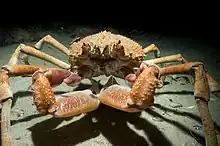Leptomithrax gaimardii
Leptomithrax gaimardii (common name - Great spider-crab) is a species of crab in the Majidae family, first described by Henri Milne-Edwards in 1834 as Paramithrax gaimardii,[3][4] from a specimen (erroneously said to be) found in New Zealand waters[3] by Joseph Paul Gaimard who is honoured by the species epithet.[4]
| Leptomithrax gaimardii | |
|---|---|
 | |
| Source[1] | |
| Scientific classification | |
| Domain: | Eukaryota |
| Kingdom: | Animalia |
| Phylum: | Arthropoda |
| Class: | Malacostraca |
| Order: | Decapoda |
| Suborder: | Pleocyemata |
| Infraorder: | Brachyura |
| Family: | Majidae |
| Genus: | Leptomithrax |
| Species: | L. gaimardii |
| Binomial name | |
| Leptomithrax gaimardii (H.Milne Edwards, 1834) | |
| Synonyms[2] | |
|
Leptomithrax spinulosus Haswell, 188 | |
It is found in coastal waters of Western Australia, South Australia, Victoria, New South Wales, and Tasmania.[3][2]
Description
This crab has a red-brown rounded carapace up to 16 cm wide and has a leg span of up to 40 cm.[1] Sometimes seaweed and sponges attach to its body. [1]
When breeding these crabs form groups of often greater than 100 crabs, Breeding occurs just before winter moulting when they are vulnerable to predation because of their soft shells. The large congregations make them less vulnerable.[1] The crab is a scavenger, and is found in seaweed, reef and sand areas at depths of up to 820 m.[1]
References
- "Leptomithrax gaimardii (Milne Edwards, 1834), Giant Spider Crab". Museums Victoria Collections. Retrieved 15 September 2022.
- "Leptomithrax gaimardii (H.Milne Edwards, 1834)". www.gbif.org. Retrieved 15 September 2022.
- "Australian Faunal Directory: Leptomithrax gaimardi". biodiversity.org.au. Retrieved 15 September 2022.
- Milne-Edwards, H. (1834), Histoire naturelle des crustacés : comprenant l'anatomie, la physiologie et la classification de ces animaux. (in French), vol. 1, Paris: Librairie encyclopédique de Roret, p. i-xxxv, 1-468 [325], doi:10.5962/BHL.TITLE.16170, OCLC 3681334, Wikidata Q51422561
External links
- Leptomithrax gaimardii occurrence data from GBIF
 Media related to Leptomithrax gaimardii at Wikimedia Commons
Media related to Leptomithrax gaimardii at Wikimedia Commons